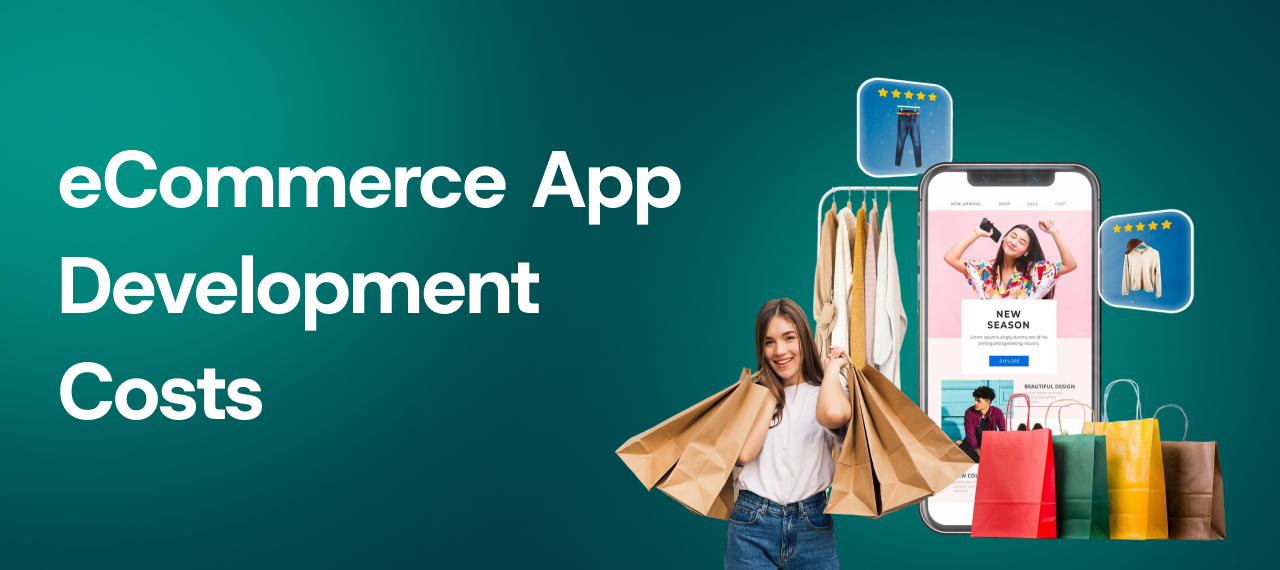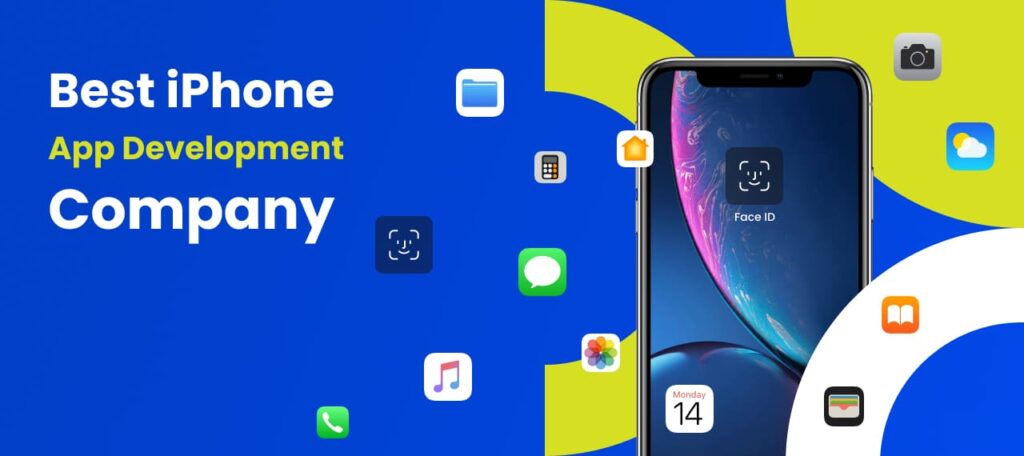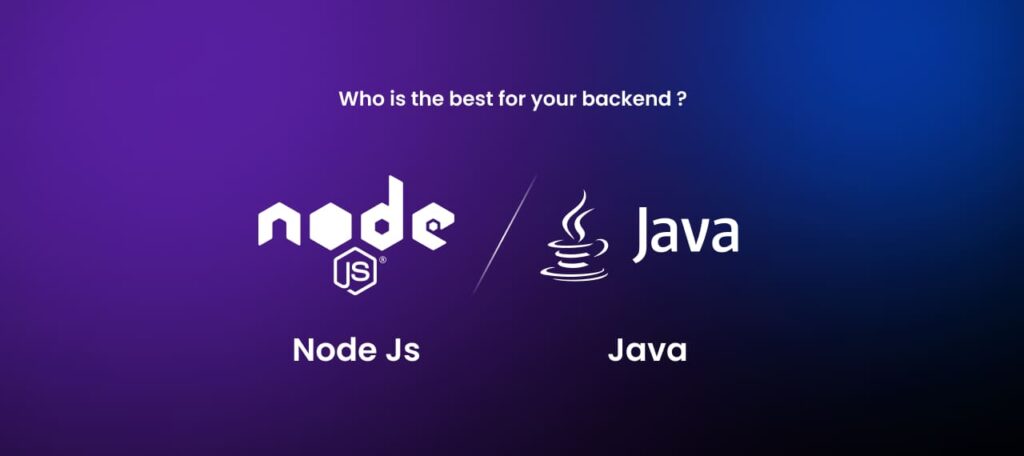You are ready to launch an online store that gives your customers a trendy, personalized shopping experience right on their handheld screen. Now the key question is how an e-commerce app development will cost? The cost of building an eCommerce app project can widely vary based on features, size of the store, and how deep you go to deliver a delightful shopping experience. The cost can range from $40,000 for a basic app to more than $300,000 for a feature-packed online store with large product catalogs and advanced tools.
To help you budget your e-commerce app project and to avoid any unwanted surprises, here we are going to provide an in-depth guide. Stay tuned to the end of this guide, where we will explore the following:
- The real cost of creating an online store app
- What makes the price go up (and how to keep it in check)
- The time it takes to launch your app
- Why your business needs an online store app
- The types of online store apps you can develop
- Must-have features, plus some high-tech add-ons
- A guide to bring your app idea to life
- Ways to earn money from your app
- Advice to keep your costs under control
What is an eCommerce Mobile App?
An eCommerce mobile app serves as a digital storefront, enabling users to buy and sell products from their smartphones. It functions as your always-open shop available whenever customers want to browse. Users can scroll through items, compare prices, and make purchases without leaving their homes.
Irrespective of the cost of app development, in today’s mobile shopping era, having a dedicated app for online shopping is no longer optional. Companies are embracing mobile apps for their online stores to expand their reach, boost sales, and foster customer loyalty. The e-commerce mobile application development has given rise to a trend that already caught the eye of investors and businesses across both B2B and B2C segments.
Compared to a website responsively built for mobile shopping, a dedicated eCommerce mobile app brings some serious benefits including:
- A smoother, more engaging experience that keeps shoppers hooked
- Lightning-fast performance on phones and tablets
- A spot in app stores and on users’ home screens
- Tailored recommendations that feel personal
- A seamless flow across all your marketing channels
- Deep-dive analytics that give you the edge over basic website stats
Why eCommerce Apps Are Taking Over
The online shopping world is absolutely exploding in 2025, and it’s the perfect time for e-commerce mobile app development. A report from BCG says eCommerce will make up 41% of global retail by 2027, up from just 18% back in 2017, growing at a steady 9% a year. A McKinsey report focusing on the social-commerce market, think shopping via Instagram or TikTok, will top $2 trillion this year.
PwC found that almost half of shoppers (48%) used a brand’s app while in a physical store in 2024, showing how mobile’s taking over. Statista predicts the U.S. eCommerce market will blow past $1.5 trillion by 2026, with each user spending about $4,650 on average by late 2025. And another survey by BCG and the World Retail Congress showed 60% of retail bosses are pouring money into eCommerce, doubling down on digital.
All these figures loudly tell us the indomitable traction around e-commerce application development from all around. With online sales soaring, mobile leading the charge, and more people shopping using their handheld devices, an eCommerce app is your ticket to staying in the game and generating business conversions.
Why Do You Need an eCommerce App?
If you are still concerned more about the e-commerce mobile app development cost vs the advantages it can bring to the table, here below we mention some undeniable competitive benefits.
It’s A Business Conversion Machine
Dedicated apps for e-commerce stores make shopping a breeze. The interactions are effortless, tapping to order, saving the cart, creating a wishlist, checking out with saved credentials and address details and grabbing a discount with coupon code sent to your phone instantly. When shopping becomes such easy, people buy more, and that’s how the app becomes your conversion engine, not just a storefront.
Get Up Close and Personal
One of the primary reasons for businesses to lean towards e-commerce app development is the scope of connecting each individual customer in a meaningful way to drive sales and brand loyalty. An e-commerce app lets you ping customers directly with push notifications, in-app chats, or lure them with custom offers. By digging deeper into the customer data, you can create messaging that instantly engages them.
Grow By Sharing
Personal touches and ease of sharing across social channels right through the e-commerce store screen allows reaching out to more customers and extending your circles. A mobile app through instant messages about loyalty rewards or personalised deals can build brand loyalty and push your customers to become small brand ambassadors in their own circles.
Know Your Customers Inside Out
Knowing customers is basic to any business growth plan, and customer knowledge cannot be static. It evolves with customer interactions and a mobile e-commerce app by pulling out a lot of data about customer behaviour, preferences, likes, and dislikes can help you moderate your catalogs, personalise recommendations, and create a delightful shopping experience for each individual customer.
Built to Grow With You
A custom e-commerce app scales up in capacity and capabilities as your business grows. The modular architecture leveraged by modern e-commerce app development projects ensure optimum scalability. For example, as session times for average customers get longer, the backend operation can scale up to accommodate more traffic and when customer signals show their preferences for some new payment options, the app can integrate them.
What Kind of eCommerce App Should You Build?

Now you must be asking how to build an ecommerce mobile app that makes most of these advantages? Well, to begin with, you must decide you want to build. The type of app you go for shapes almost everything, cost, scope, required resources and timeline. Let’s check the popular options.
1. Single-Store App
Single store apps are ideal for businesses selling their own products or services through a branded online shop. If you are selling your own branded services or products to customers directly, you can build a storefront equipped with product catalogs and other e-commerce features. Some single store apps are created by adding storefront interface and e-commerce features to the existing business websites.
2. Multi-Vendor Marketplace
Multi-vendor marketplace apps allow tons of sellers to list their products and services. The biggest and most obvious examples can be Amazon or Flipkart. There can also be niche specific multi-vendor marketplace apps like fashion stores or e-medicine stores selling products from multiple companies belonging to a particular niche.
3. B2B App (Business to Business)
B2B ecommerce apps cater to other businesses. A wholesaler app from which retailers can purchase goods in bulk is a nice example of this. Storefronts of machine parts that cater to manufacturing businesses can also be a good example of this. Custom pricing, bulk orders, wholesale deals and multi-user setups, are some of the key attributes of such stores.
4. C2C App (Consumer to Consumer)
Another popular type of e-commerce app is the Customer to Customer (C2C) app that allows people to buy and sell goods from each other. Here the e-commerce app offers a platform for people to buy and sell goods among themselves, while the app takes a commission for each item sold or bought. Some of the most popular C2C apps include Craigslist or eBay.
5. D2C App (Direct to Consumer)
Some brands can sell directly to consumers through their own e-commerce apps. Such apps that are categorised as Direct-to-Customer or D2C apps do away with intermediaries and middlemen to sell their goods to customers. Some of the leading examples of D2C apps include Nike and Glossier.
6. On-Demand App
The typical e-commerce apps that cater on-demand services such as food delivery or grocery delivery apps are now hugely popular. These apps work like a platform to allow multiple brands to sell their products directly to customers while customers can choose the sellers, compare pricing, and track the location of the delivery agent right within the app. Some of the most popular apps in this category include Zomato, Glossier, 1mg, Blinkit, BigBasket, and many others.
7. Social Commerce App
Social commerce storefronts targeting social media audiences in platforms like Facebook, Instagram, Pinterest, and other platforms are now trending. Social commerce apps heavily rely on social media and community shopping features like sharing, influencer stores, and in-app social promotions.
Picking the right app type means you can zero in on features your audience will love. But to make it happen, you will need a pro e-commerce app development team by your side.
How Much Will an eCommerce App Set You Back in 2025?
The eCommerce application development cost swings wildly based on how fancy you want it, what features you’re packing in, whether you go native or hybrid, and who’s building it. Here’s a rough breakdown by complexity:
| App Type | Build Time | Price Range |
| Simple | 2–3 months | $40,000–$60,000 |
| Mid-Tier | 3–6 months | $61,000–$150,000 |
| Complex | 9+ months | $300,000+ |
These are just gross figures, your actual cost depends on the details. A quick way to estimate is:
Total Price = Hours Needed × Team’s Hourly Rate
Breaking it down by project phase helps you budget better. Here is a rough guideline.
| Phase | Timeframe | Cost Estimate |
| Research & Planning | 2–4 weeks | $2,000–$10,000 |
| Design | 4–6 weeks | $5,000–$20,000 |
| Coding | 8–20+ weeks | $20,000–$150,000+ |
| Testing | 2–4 weeks | $5,000–$30,000 |
| Launch | 1–2 weeks | $3,000–$15,000 |
| Maintenance (Ongoing) | Monthly | $1,000–$10,000 |
Your ultimate e-commerce app development cost estimate hinges on your app-specific attributes.
What’s Driving the Cost of Your eCommerce App?
To get a firm control on the cost of your e-commerce mobile app development project, you should carry out a detailed analysis of the key constituent factors pushing the cost of development. Here we explain these factors.
1. How Complicated Is Your App?
The more bells and whistles, the bigger the bill. A basic app with a small product list and simple look is cheap compared to one loaded with AI recommendations, real-time tracking, or custom integrations. Things that are likely to add complexity to an app project include the following:
- How many features you are throwing in
- How tricky the business logic is
- Number of screens or buttons
- Fancy user experience tweaks (like a slick checkout)
- The tech backbone of the app
- Customer support extras, like live chat
B2B apps often need heavier features, like client portals, so they tend to cost more than B2C ones.
| Basic App | Mid-Tier App | High-End App |
| Core features (search, account, checkout, notifications), light tweaks | Payment integrations, custom design, extras (chatbots, loyalty rewards, wishlist) | Deep user research, live inventory sync, ERP/CRM links, AI personalization, AR/VR, speed optimization |
2. Design and User Vibes
A great app needs a design that attract users at first sight. That starts with digging into what users want, building your brand’s look, and crafting a user experience that feels just right. Mobile apps need different design tricks than websites, especially for B2B. A pro partner can nail this, but custom designs cost more, delivering better engagement and loyalty.
3. Build Style
iOS and Android run on different systems, so your build choice matters:
Native – $50,000–$300,000
Cross-Platform – $40,000–$200,000
Hybrid – $30,000–$200,000
- Native: Built just for iOS or Android, super smooth, fast, and secure, but you can’t reuse the code across platforms.
- Cross-Platform: Works everywhere but might miss some native perks and run slower.
- Hybrid: Blends both, using one backend with native views for a near-native feel.
Native apps cost more but shine in performance, while cross-platform or hybrid apps can save cash but might compromise quality.
4. Who’s Building It and Where
You can code in-house, hire a freelancer, or team up with an agency or outsourcing crew. Freelancers are cheap but dicey—quality’s hit-or-miss, and delays are common. Agencies and outsourcing firms bring full teams for strategy, design, and coding.
- In-House: $40,000–$80,000
- Freelancer: $10,000–$25,000
- Local Agency: $50,000–$60,000
- Outsourcing Partner: $10,000–$31,500
Prices vary by location as well. For example, e-commerce development companies in the U.S., U,K and Australia charge highest rates while you can hire e-commerce development companies in India and Eastern Europe in much cheaper rate without sacrificing the qualitative parameters.
5. Hooking Up with Other Tools
Connecting your app to payment systems, shipping services, CRMs or analytics platforms isn’t a walk in the park. Each connection adds work and dollars, especially if you need custom fixes to make it all work.
6. Making Sure It Works
Testing is your safety net for a glitch-free app. Regular checks catch bugs, boost performance, and lock down security. Outsourcing testing might cost $5,000–$18,000, but it’s worth it to avoid expensive fixes later.
7. Keeping It Safe and Legal
Protecting customer data, especially payments, means beefy security like encryption and fraud alerts, plus meeting rules like PCI-DSS. That’s extra work and certifications, which cost more.
8. Keeping the Lights On
After launch, your app needs TLC—updates, bug squashing, new features. Expect to shell out about 20% of your build cost yearly for hosting, services, and security patches.
9. Sneaky Costs to Watch Out For
Some expenses creep up if you’re not looking:
- Servers and Storage: More users mean bigger cloud bills, especially during sales spikes.
- App Store Fees: Yearly charges for Apple and Google, plus fixes for rule slip-ups.
- Support Tools: Adding chatbots or CRM links late can sting.
- Device Testing: Checking every phone and OS version takes time.
- Data Backups: Protecting user info needs ongoing systems.
- Speed Tweaks: High traffic demands optimization tricks.
- Deep Analytics: Fancy tools for insights add backend costs.
10. Getting the Word Out
A great app is useless if no one knows about it. Budget for app store optimisation, social media, influencer shoutouts and ads.
11. Unique Features
Want something custom like a custom payment flow or special analytics? That takes extra time and skill, so expect a bigger bill.
Features Your eCommerce App Can’t Do Without
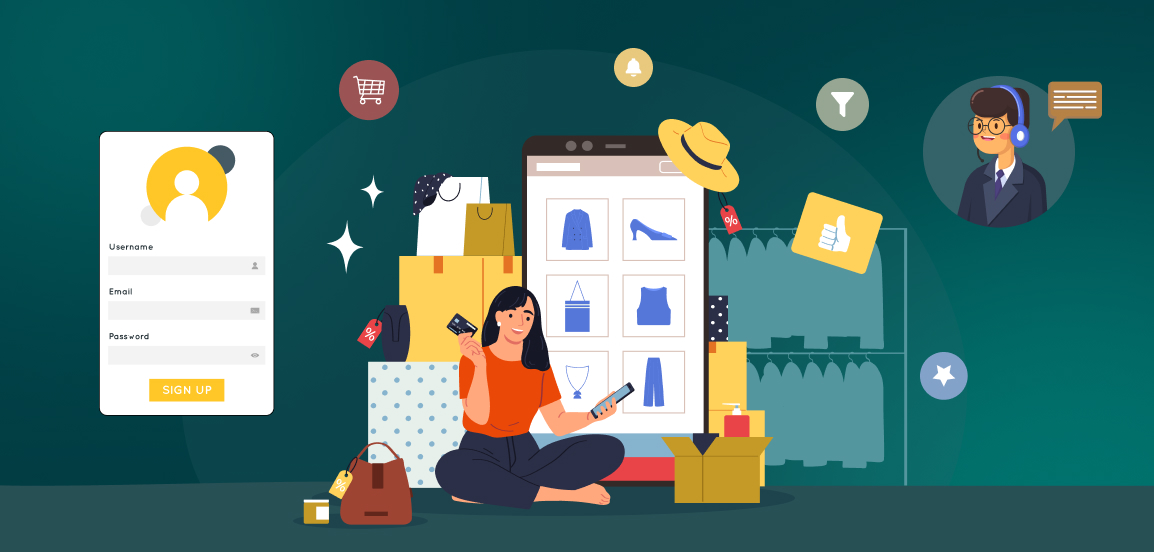
To make your app a hit with shoppers and a breeze to run, you need a solid mix of features for users and your team. These are the nuts and bolts of a great app.
Buyer Features
These make the buying process smooth and fun from browsing to follow-ups:
- Quick Sign-Up: Sign up with email, phone or social media in seconds.
- Profile Control: Update details, save addresses or manage payment options.
- Product Browsing: Browse categories with ease.
- Smart Filters: Filter by price, brand or reviews to find stuff fast.
- Product Info: Clear pics, descriptions and prices to help decide.
- Wishlist: Save items for later to keep users coming back.
- Cart: Check items, adjust quantities and go to checkout.
- Safe Checkout: Locked down payments with saved or new payment methods.
- Payment Options: Cards, wallets, UPI or cash on delivery.
- Order Tracking: Track shipments with real-time info.
- Purchase History: See past orders and reorder quick.
- Notifications: Ping for deals, cart reminders or order updates.
- Reviews: Share and read reviews to build trust.
- Help Desk: Chat, bots or direct support for quick fixes.
- Returns: Easy way to start and track refunds.
- Rewards Program: Points for buying to keep users hooked.
- Global Options: Switch languages or currencies for worldwide use.
- Referrals: Invite friends for discounts.
Backend Features
These let your team run the show smoothly, from stock to support:
- Admin Access: Logins with roles like boss, manager, or editor.
- Big-Picture Dashboard: See orders, sales, and stock at a glance.
- Product Control: Add, edit, or yank items and prices.
- Stock Alerts: Know when inventory’s low.
- Order Handling: Check, change, or ship orders with updates.
- Customer Profiles: View users, answer questions, track habits.
- Deals and Coupons: Set up flash sales or codes.
- Shipping & Taxes: Tweak delivery zones and tax rules.
- Content Updates: Manage banners, blogs, or terms.
- Notification Blasts: Send targeted promos to users.
- Data Reports: Spot trends, top items, or busy times.
- Review Oversight: Approve or reply to feedback.
- Refund System: Handle returns smoothly.
- User Tracking: See where shoppers get stuck.
- Payment Monitoring: Catch failed payments or disputes.
- Multi-Region Support: Offer local languages and currencies.
Cool AI Features to Make Your App Pop
With every app sporting the basics, AI-powered extras can give yours a real edge, making shopping feel personal and effortless. Here’s what’s trending:
- Picture Search: Snap a photo to find products—no typing needed.
- Virtual Try-Ons: Test clothes or decor in AR to cut down returns.
- Voice Orders: Shop hands-free with voice commands.
- Stock Smarts: AI predicts what to stock, saving on overbuying.
- Fraud Watch: Spots sketchy transactions to keep things safe.
- Chatbots: Help users find stuff or fix issues fast.
- Price Shifts: Tweak prices based on demand or competition.
- Clever Search: Catches typos and shows spot-on results.
- Cart Nudges: Ping users about forgotten items or sales.
- Personalized Picks: Suggests products based on what users love.
- Custom Designs: Let shoppers tweak items with live price updates.
- Auto Invoices: Sends bills and links to accounting tools.
- Smart Dashboard: Shows who’s buying what and who might bounce.
- Game-Like Fun: Spin wheels or earn rewards to keep users engaged.
- Quick Reorders: One-tap buys for frequent purchases.
How to Build Your eCommerce App, Step by Step
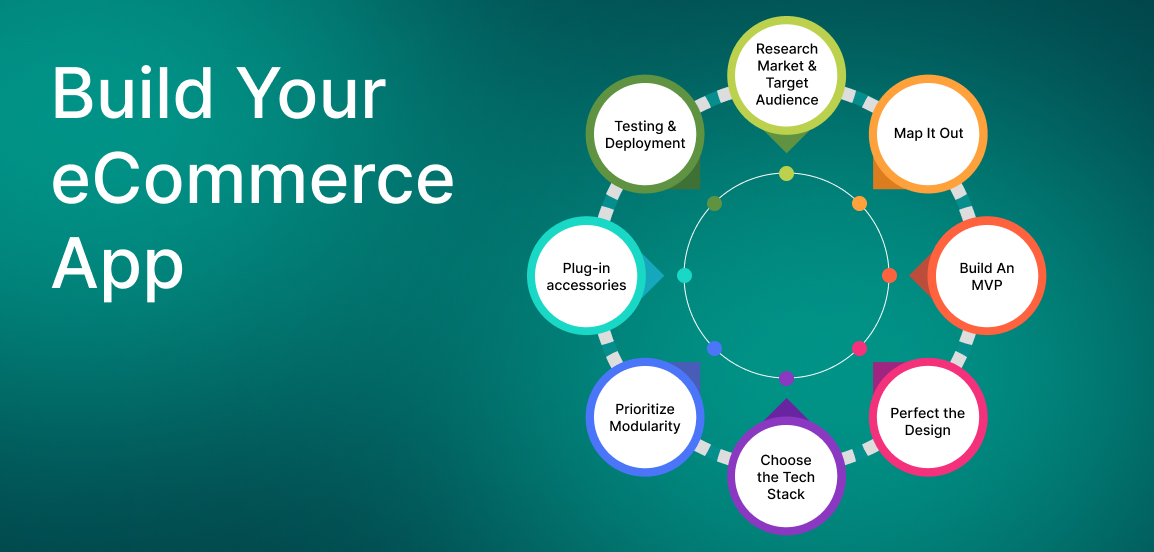
To cut the confusion of so many considerations and factors, we will now explain how to build an ecommerce mobile app in a step-by-step manner. Here’s how the roadmap looks like:
1. Research Market & Target Audience
Start by carrying out the tensile market research. Prepare a list of top mobile e-commerce store in your niche segment and analyse their strengths, weaknesses, and what has been their journey in becoming a successful app. Understand how they won over shortcomings and leveraged unique features, user experience elements, and advanced technologies to become what they are now. Now make a similar deep research about your target audience and prepare the ideal customer personas with typical likes, dislikes, preferences, shopping behaviour, and buying power. Lastly, analyze the market trends that shape the latest buzz in your segment and drive business conversion.
2. Map It Out
Once your market and audience research is done, it is time to make a very detailed plan with every aspect of the app project prioritized in a systematic manner.
- List out the must-have features followed by nice-to-have features that you can roll out in the future
- Choose your OS platform, configuration and tools like ERP or stock systems
- Plan an MVP rollout budget and timeline
- Build a team, involving both in-house and outsourced experts
It is always advisable to opt for a headless commerce app that can run on multiple OS platforms offering an omnichannel vibe while keeping the cost lower thanks to the shared codebases,
3. Build An MVP
MVP or minimum viable product is not just a testing concept, it is now a crucial first step for any successful e-commerce app development project. It is about rolling out the primary version of the app with elementary and must-have features and user experience attributes. Make sure your MVP at least offers the core user experience as per your project goal while keeping room for further enhancements and value additions through subsequent upgrades. This will also help you with a minimum initial cost of development and incremental budget planning.
4. Perfect the Design
Make user-friendly processes for administrators and customers, emphasizing layouts that are sales-driven, mobile-first, and easy to access. Create wireframes, test prototypes, and assess usability. Knowledge of mobile design helps you stay aligned to tried and tested benchmarks and achieve the most engaging UX design.
5. Choose the Tech Stack
Now you have a varied and sophisticated tech stack to choose from ranging from frontend options like React Native and Flutter to backend choices like Node.js and Django to cloud platforms like AWS and Azure. Besides considering cost, think about the viability of the tech stack as per the projected evolution of the store and the future integrations, features and expansions you need.
6. Prioritize Modularity
Always opt for modular architecture for your e-commerce mobile app development project to ensure easy scalability and flexibility to make value additions without reworking on the entire app. This is important to keep your app maintenance and update cost lower. Build easily configurable admin dashboard and admin tools, use lightweight and reputed integrations and APIs and leverage UI that allows making quick changes.
7. Plug-in accessories
When choosing must-have plugins, choose CRM solutions like HubSpot, analytics tools like Google Analytics or Mixpanel, or payment gateways like Stripe and PayPal. When integrating payment gateways, consider the following:
- Pick global providers for multi-currency and tax support
- Lock it down with PCI-DSS and encryption
- Add currency switching
- Watch for fraud
- Test in sandbox mode
8. Testing & Deployment
Before submitting the app to mobile app stores, carry out rigorous testing combining both automation testing tools and manual testing experts. Throughout the design and development process, make sure you do A/B testing for each interactive elements to ensure desired output. Make sure to tweak the iOS, Android and web versions of the app to meet the respective platform-specific UI guidelines and rules.
- Carry out app store optimization following the best practices laid out by the respective platforms.
- Carry out pre-launch campaigns through press releases, emails, events and social media promotions.
- Collaborate with leading industry influencers of your niche to create early buzz.
- Curve out a budget for paid campaigns and ads across search engines, social media, web and streaming platforms.
Get more details on How Long Does It Take to Build an E-commerce App
How to Keep Your Budget in Line
All that we have discussed so far have already given you a fair idea of how to control your e-commerce app development cost. Now before we bid adieu, let’s provide some useful tips to keep a tighter control on your app development budget. Here we go.
- A Clear Plan: A clear plan with short-term and long-term objectives will save you from costly deviations and destructions.
- Start Lean: Always build an MVP first showcasing the must-have features and test the market before unleashing your entire bucket of unique features and elements.
- Take Quotes from All Around: Always compare a lot of development companies, agencies, freelancers, and outsourcing options, shortlist, compare skill set vs costs, additional value offerings and terms and conditions.
Go Open-Source: To keep cost at a minimum level, opt for open-source choices like Magento or React Native and save on license fees. - Go Cross-Platform: Always opt for cross-platform development to make your storefront live across iOS, Android and web at the same time.
- Use Pay-as-you-go Cloud Plans: Both AWS or Azure offers pay-as-you-go plans ensuring incremental budget management and scalability as your growth story unfolds.
- Automate Tests: Make use of automation tests wherever possible, especially for bugs detection and load testing. These automated testing tools can save cost compared to manual testing.
Leverage the E-commerce Thought Leadership with EncodeDots
We at EncodeDots know what it takes to shape the e-commerce success story. Though every successful e-commerce app is unique, the quest for unique and delightful shopping experience that stays with visitors, is common. All our e-commerce app development projects bear the testimonies of this quest. Whether you are a regional business trying to make your pan-India or global footprint with a killer storefront or you are a global corporation trying to revamp your customer experience by leveraging latest tech, we at EncodeDots can deliver the right solution tailored to your needs and aspirations.
Some of the key reasons why both global corporations and promising startups always look forward to us for their e-commerce app projects:
- A portfolio of market leading e-commerce apps that redefined competition in their segments
- Most varied teams of e-commerce experts across most advanced and sought-after tech stacks.
- With our value-for-money pricing you get a lot more than what you get in the same price tag from others.
- We create articulate incremental development plans to help your app grow, scale and achieve the pinnacle of success in small steps.
- Our development journey starts from consultation and brainstorming and continues through support for the entire app lifecycle.
The Bottom Line
As a final reminder, let us not forget the mistake of over-emphasizing development cost. Despite all the cost control and budgeting measures, at some point you need to prioritize quality over cost and expertise over low-cost resources. This is why it is always advisable to choose a middle path balancing both budget and the mission-critical quality attributes. For instance, most sophisticated and intuitive UI/UX design may require industry-best experts adding significantly to your budget. But you cannot compromise a critical area like UI/UX design just to stick to your budget. On the other hand, you should go all out to embrace the best cost-control and resource-utilization practices to make the most of your development budget.
FAQs
How long does it actually take to build an eCommerce app?
What really affects the cost of building an eCommerce app?
How do you make sure your eCommerce app handles secure multi-currency payments?
So how much does it really cost to build an eCommerce app?
Is it cheaper to build an eCommerce app in India?
How can I reduce app development costs without compromising quality?
Are there ongoing costs after launch?
Do I need a website if I am already building an app?
Table of Contents
- What is an eCommerce Mobile App?
- Why eCommerce Apps Are Taking Over
- Why Do You Need an eCommerce App?
- What Kind of eCommerce App Should You Build?
- How Much Will an eCommerce App Set You Back in 2025?
- What’s Driving the Cost of Your eCommerce App?
- Features Your eCommerce App Can’t Do Without
- Cool AI Features to Make Your App Pop
- How to Build Your eCommerce App, Step by Step
- How to Keep Your Budget in Line
- Leverage the E-commerce Thought Leadership with EncodeDots
- The Bottom Line
- FAQs







